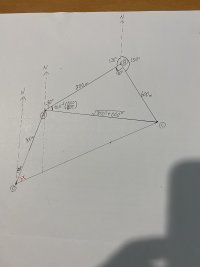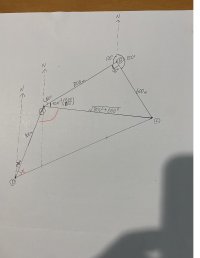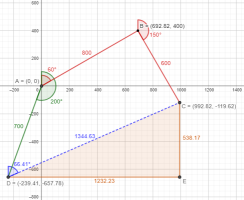I have a difficulty answering Question b) of the following:
Aria is doing the running leg of a triathlon course.
From the start point, A, she runs 800 m at a bearing of 060 degrees.
She then runs 600 m at a bearing of 150 degrees.
a) Calculate Aria's bearing from the start point A to the end point of the run.
b) Aria stays at the point she has reached.
Rob runs 700 m at a bearing of 200 degrees from the start point A.
Calculate Aria's bearing from where Rob has reached.
I can work out question a) as follows:
60 + tan-1(600/800) =097 degrees.
But I have difficulty working out question b).
I know that I could work it out if I found the angle size indicated at "x" on the photo attached, but I have no clue how to find it.
Also I must add to say that this is supposed to be a very basic trigonometric question where you can answer with the basic knowledge of Pythagoras theorem, sin/cos/tan and inverse trig, and it should be worked out applying things like sin/cos rules.
I would much appreciate it if someone can help me with this.
Thank you.
P.S. The textbook says that the answer is 066 degrees, but with no working written on it!
Aria is doing the running leg of a triathlon course.
From the start point, A, she runs 800 m at a bearing of 060 degrees.
She then runs 600 m at a bearing of 150 degrees.
a) Calculate Aria's bearing from the start point A to the end point of the run.
b) Aria stays at the point she has reached.
Rob runs 700 m at a bearing of 200 degrees from the start point A.
Calculate Aria's bearing from where Rob has reached.
I can work out question a) as follows:
60 + tan-1(600/800) =097 degrees.
But I have difficulty working out question b).
I know that I could work it out if I found the angle size indicated at "x" on the photo attached, but I have no clue how to find it.
Also I must add to say that this is supposed to be a very basic trigonometric question where you can answer with the basic knowledge of Pythagoras theorem, sin/cos/tan and inverse trig, and it should be worked out applying things like sin/cos rules.
I would much appreciate it if someone can help me with this.
Thank you.
P.S. The textbook says that the answer is 066 degrees, but with no working written on it!



